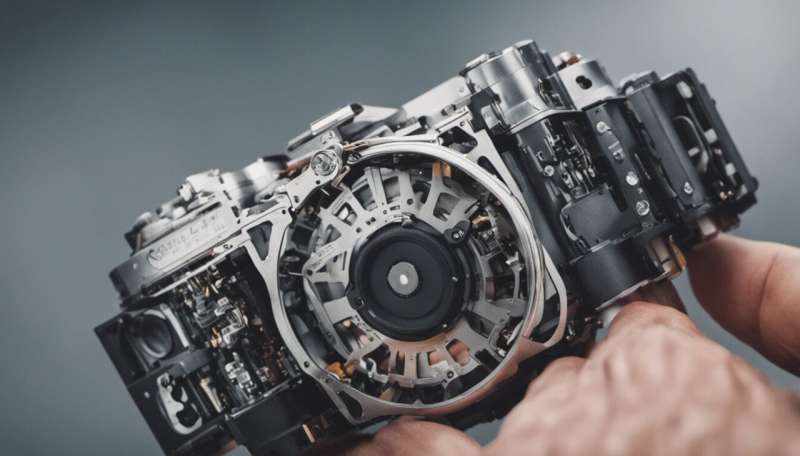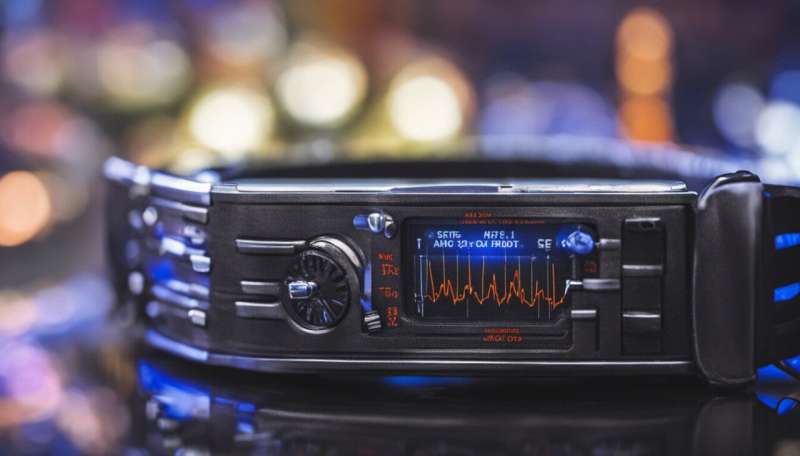This article has been reviewed according to Science X's editorial process and policies. Editors have highlighted the following attributes while ensuring the content's credibility:
fact-checked
trusted source
written by researcher(s)
proofread
New wrist-worn device can quickly tell if you're having a heart attack

Scientists have developed a wrist-worn device that could revolutionize treating heart attacks by speeding up diagnosis—without the need to draw blood (the current method).
Over 700,000 people visit A&E in England and Wales because of chest pain. And they account for 25% of medical admissions to hospital.
These patients usually have varying symptoms, related complex health conditions, and are often on several medications. Assessing them is difficult. But it usually includes reviewing their medical history, taking a heart trace of the electrical activity of the heart (called an electrocardiogram), and taking a chest X-ray.
The electrocardiogram, or ECG, can show changes in the heart rhythm associated with a heart attack in about 50% of patients. The remainder do not show an altered rhythm and need further investigations. These include important blood tests.
One test is for a protein found in the heart cells called troponin. This protein plays a key role in making the muscle cells in the heart contract and relax. When cells are starved of oxygen due to a blockage in the arteries that supply blood to the heart, the cells start to die and release troponin into the blood supply.
The troponin can be measured in a hospital laboratory from a sample taken from a patient—normally from a vein in the crease of the elbow or from a catheter in the back of the hand. This test is repeated two or three hours after the patient is admitted.
A change in the amount of troponin in the blood can indicate a heart attack. This is especially useful for the patients who do not show any changes on the ECG.

Patients with a diagnosis of a heart attack need urgent treatment, normally by surgery where a catheter is fed into the blocked artery in the heart and a balloon is blown up to open the blockage. This procedure is called an angioplasty. In many cases a metal mesh tube called a stent is inserted along with the balloon. When the balloon is deflated the stent stays in place to keep the artery open.
But this troponin blood test requires someone to draw blood. It is common for people to have a fear of needles—needle phobia affects between 4% and 10% of the population. The anxiety and stress can make chest pain worse.
No blood sample required
The new wrist-worn device can measure troponin without taking a blood sample. This device is worn on the wrist like a smartwatch. It uses infrared light across the skin layers (transdermally) to detect troponin in the blood system.
A recent study, published in European Heart Journal—Digital Health, has shown this device can detect 90% of heart attacks within five minutes. "With this level of accuracy, if you use this device and it comes out positive, you're fairly sure this patient can be admitted for fast-tracking diagnostic tests, treatment and intervention," the study's lead author, Dr. Partho P. Sengupta, said.
If larger studies confirm these early findings, this revolutionary device for detecting troponin could prove useful for detecting heart attacks in GP surgeries, or for emergency services who first attend a patient with chest pain. It also means patients would not have to wait for blood samples to be sent to the laboratory, analyzed and results returned when they arrive at the hospital.
It is important that patients have a fully functional supply of blood to the heart as quickly as possible to stop more heart cells dying. As the saying in cardiology goes: time is muscle. This new wrist-worn device could speed up diagnosis and treatment of patients with chest pain.
The technology could also potentially be used for other tests to detect blood clots, ectopic pregnancy or sepsis. And it could be a lifeline for those people with severe needle phobia.
More information: Shantanu Sengupta et al, A novel breakthrough in wrist-worn transdermal troponin-I-sensor assessment for acute myocardial infarction, European Heart Journal—Digital Health (2023). DOI: 10.1093/ehjdh/ztad015
This article is republished from The Conversation under a Creative Commons license. Read the original article.![]()



















